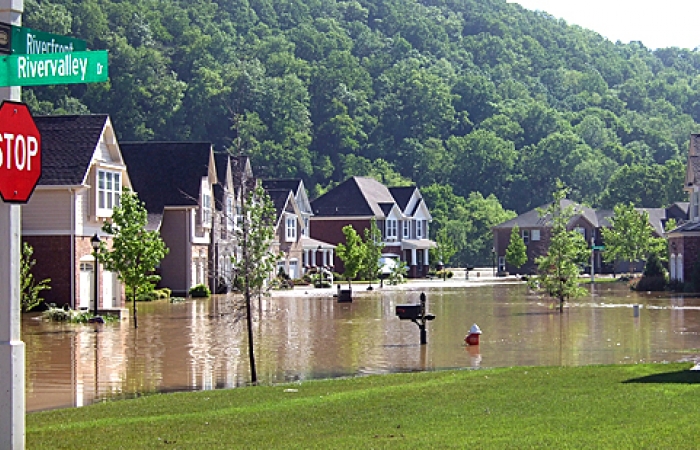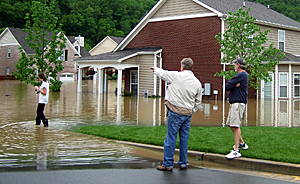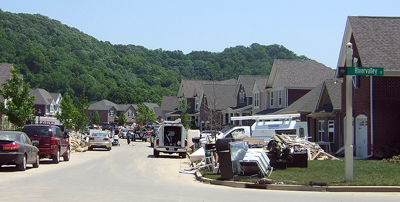
Floods, Emergency Prep and Me

When a 1,000-year storm hit Nashville, a writer with muscular dystrophy learned the truth of the adage ‘it’s all about neighbors helping neighbors’
Devastating. Humbling. Unifying. Frightening.
Those are words that echoed through Nashville on the weekend of May 1, 2010, when the area was hit by a storm of Biblical proportions — a storm that would ultimately change the face of this beautiful city.
Although I’ve written in the past about disaster preparation for Quest readers, there is nothing like firsthand experience. Here, then, is my story.
And the rains came …
For the past seven years, I’ve volunteered for a nonprofit animal rescue, and I spent Friday, April 29, 2010, like any other: coordinating adoptions in anticipation of another busy weekend.
The weather forecast was typical for spring — mild temps and rain. The rain began Friday evening and continued to pour down early Saturday morning as I loaded up my van. A neighbor walked past and hollered, “We’re OK so far, she’s holding!” He was referring to the Harpeth River, which is a half-block from my house and down an embankment which drops 100 feet in places.
“He’s a little paranoid,” I thought to myself as I drove off. I maneuvered slowly through standing water on the road, making a mental note to go home another way that evening.

Little did I know this highway soon would be washed away.
Arriving home about 5 p.m., I clicked on the local news to footage of cars submerged underwater on Interstate 24 just outside of Nashville. Water covered the hoods of semi-trucks, and their drivers were swimming out their cab windows and into rescue boats.
I watched as a portable school building emblazoned in large letters with the word HOPE (used by missionaries at a nearby Christian school) came bobbing down the Interstate, crashed into a semi and fell into pieces — footage that later made national news. It was only one of many schools that lost buildings that weekend.
About an hour after arriving home, I lost power. Taking advantage of a brief lull in the rain, I joined my neighbors gathered at the end of my street and discovered our lazy little river had relocated and now was roaring past flooded homes. The entire scene was surreal. A truck drove up and unloaded a bass boat onto my street in chest high water. A neighbor offered to manually open my electric garage door so I could get out if I needed.
“Get out and go where, with my herd of eight dogs?” I wondered. My thought was interrupted by deep, guttural moaning sounds like nothing I’ve ever heard before.
“What’s that?” I asked.
“It’s the cliffs above the river giving way,” she said.
I looked up and saw mudslides clearing trees from the steep cliffs bordering the other side of the river. Emitting low moans, the wide swaths slowly oozed down onto the highway I’d driven just that morning. Homes on both sides of my cross street were submerged almost to their roof lines. Six-foot backyard fences were being topped by the brown water.
I returned to my house with several neighbors’ phone numbers in my cell. I wasn’t sure if opening my garage door was the smartest thing to do, as it would allow water to more quickly enter my one-story wheelchair-customized home, so I opted to wait on that.
If I didn’t have eight dogs (including rescues from the shelter), I would have left at that moment, like any sane person. (But then, a sane person wouldn’t have eight dogs to begin with.)
Survival mode kicked in as I recalled a Quest article I’d written just a few years ago about disaster preparedness. I filled up several empty Gatorade jugs from the shelter with water, found candles and flashlights, fed the dogs and put my blood pressure meds in my purse. I then loaded up my car with dog food, more water, bowls, my hard drive and wheelchair battery charger, just in case I had to leave in a hurry. Leashes hung by the door.
An hour later I lost my cell signal. Texting was intermittent and land lines were down. Optimistic, I charged my cell using my car charger "just in case."
This is the point in my Quest story where I had advised readers to evacuate while it was still possible. Better to go now in your car than by raft later without your wheelchair, I’d warned. Do as I say, not as I do ...
I called my son and told him to stay at the restaurant where he was working over his summer break from college. The roads weren’t safe. Then I said a good, long prayer.
Most folks had already evacuated. A Sea-Doo and canoe joined the bass boat going up and down the street all along the riverfront. Interstate 40 was closed in both directions at our exit ramp and surrounding roads were underwater or washed away.
Being isolated, we became our own first responders — even though Nashville Fire Department had 900 emergency personnel who logged more than 3,300 overtime hours that weekend. That’s what it boils down to in most big disasters — neighbors helping neighbors.
By sunset, most of the neighbors had gotten out, pets included. The extent of the damage was evident, and it was only going to get worse as the rain continued to fall.
My immediate neighbors said they would be knocking on my door if they decided to leave and I should follow them out — even if it was only to the top of the street. I agreed but added that my dogs would be coming along for the ride.
The sounds were frightening as massive trees fell, and slammed into backyard decks and siding. Normally, you couldn’t see the river past a greenway behind the row of homes, but now it was rushing through their yards like a busy highway.
The water’s “traffic” was composed of huge trees, kids’ play sets, fencing, gas grills, garbage cans, and every now and then, someone’s SUV. One neighbor later told me his bass boat on a trailer in his garage was pushed up by the rising water through the ceiling, and he discovered it in his second-story bedroom.
I didn’t sleep Saturday night — nor did my dogs who barked off and on. We lay there in the blackness listening to the sound of rushing water and things crashing against other things.
My Timex read 1 a.m. when I shined a flashlight through my front window to see if there was standing water at my door. Not yet. Another check at 3 a.m. showed we were still safe but still being hammered by rain.
Drying out
By Sunday’s sunrise, the rain had slowed and several of us gathered in the street. The river had stopped four houses short of mine.
Someone “grilled” coffee on a patio fire pit. The sky was blue and life was good — unless you were one of the other 300 people in my subdivision whose houses were underwater.

By noon Sunday, the river began to recede and muddy pavement was left to dry. Brown water lines told the tale as owners returned, one by one, shocked to see what was left of their homes. It was as if a war had raged through, leaving everything from fencing, insulation, a dog house, lawn furniture and even some cattle carcasses tangled in tree branches along the river banks some 30 feet in the air.
We traded stories over coffee while helicopters buzzed overhead. That became our routine for the next several days while we helped one another empty out the ruined contents of houses.
As the magnitude of this disaster sank in, my neighbors and I grilled up everything from our freezers before it went bad and shared it with despairing gratefulness. My neighbor across the street had a generator we used for any medications needing refrigeration — and a wheelchair charge, thankfully.
When the Interstate re-opened, volunteers from all over showed up to help. Neighbors piled furniture, appliances, mountains of carpeting, kitchen cabinets, toilets and sinks, and everything they owned in their front yards for all the world to see. Some piles were higher than the roof.
Lives were forever changed — but lives also were saved. I stopped at a local school where the Red Cross offered shelter, food and water, but all I needed was a long wheelchair charge, which held me until the following week when electricity was finally restored.
The numbers
Over that two-day period, my neighborhood received 17.67 inches of rain, with similar amounts falling over 49 counties in middle Tennessee and southern Kentucky.
The National Weather Service described the storm as a “greater than 1,000-year event,” with there being a less than 0.1 percent chance of a similar rainfall ever happening again in any one year.
While we had had an abnormally dry April, the experts say we were hit by “an unseasonably strong late-spring storm system, coupled with a stationary upper air pattern, a persistent tropical moisture feed, and the timing of impulses moving through the jet stream.”
In English: A storm stalled overhead that no one could have predicted or warned us about.
The Cumberland River, covering almost 18,000 square miles (of which 60 percent is in Tennessee), was a major factor in the widespread flooding because it winds for miles through metro Nashville. On May 3, the swollen Cumberland rose to nearly 52 feet, 12 feet above flood level.
In Nashville, 24 lives were lost and more than $2 billion in property damage was sustained, including 15,000 destroyed homes. Some 15,000 people lost their jobs from flooded businesses (costing at least $3.6 billion in lost revenue).
All told, 67,683 people received almost $319 million in FEMA (Federal Emergency Management Agency) assistance and another $174 million in Small Business Administration loans.
Sadly, much of Nashville’s history also was lost when legendary sounding instruments and artifacts were destroyed in flooded instrument storage facilities, the Grand Ole Opry House and Country Music Hall of Fame. The 4-year-old Nashville Symphony Hall suffered $40 million in damage and had to have more than five million gallons of flood water drained from inside.
Neighborhoods were transformed forever. Newly designated floodways made it impossible for many home owners and businesses to rebuild. As these owners accept buyouts from the city, properties will be replaced with open “green space,” but as of October 2010, many Nashville homes still sat abandoned and thousands of families remained displaced. Many beloved pets who were surrendered to area shelters eventually had to be euthanized due to lack of space and funding.
Going forward
There are signs of progress.
That portable school building emblazoned with the word HOPE which made the national news when it floated down the Interstate in May, was replaced with a 6,000-square-foot preschool building in September by the ABC show “Extreme Makeover: Home Edition.”
Gaylord’s Opryland Hotel & Resort reopened in November and rehired 80 percent of their original employees, along with another 1,700 new hires.
When I wrote about disaster prep for Quest in 2007, I interviewed the interim director of Nashville’s Office of Emergency Management, who said that in the event of a major disaster, an informational hotline would be provided, schools and churches would be used as shelters, but “it’s really all about neighborhoods looking out for neighbors.” That reality is no doubt why the death count was not higher.
It’s still true that it’s best to be prepared rather than be put in a position where you rely on others for your safety, to heed the advice of officials and to leave before roads become unsafe for travel.
But unfortunately, we had no warning that May. Officials promise to improve communications between the National Weather Service, the Army Corps of Engineers who manage our dam projects, and Tennessee emergency management teams so they can better forecast and inform the public of impending danger — but nothing can discount the importance of knowing your neighbors.
Every time I leave my subdivision these days, I drive over a small bridge where a man was swept away in his car during the floods. His sisters discovered his body under debris four miles downstream on September 26.
I am reminded of life’s fragility by the cross they placed near the bridge, by the tree trunks displayed horizontally in supporting limbs 30 feet above the banks and by the empty homes with quiet tire swings in the front yard.
The main stage of the Grand Ole Opry, with its famous six-foot circle of wood (made from 85-year-old Opry stage wood) had been submerged under 4 feet of water. On September 28, the Grand Ole Opry reopened — ahead of schedule.
On the stage and in Nashville neighborhoods, the circle is unbroken — but we will never forget.
Jan Blaustone is a writer, teacher and Quest contributor based in Nashville, Tenn. She has limb-girdle muscular dystrophy.
MDA Resource Center: We’re Here For You
Our trained specialists are here to provide one-on-one support for every part of your journey. Send a message below or call us at 1-833-ASK-MDA1 (1-833-275-6321). If you live outside the U.S., we may be able to connect you to muscular dystrophy groups in your area, but MDA programs are only available in the U.S.
Request Information